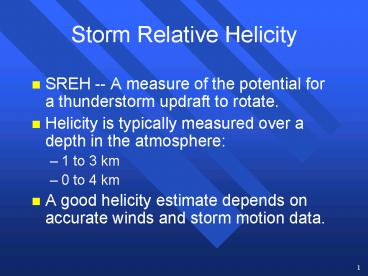Storm Relative Helicity - PowerPoint PPT Presentation
1 / 21
Title:
Storm Relative Helicity
Description:
Instability -- Cold air aloft associated with the upper ... The Cincinnati, Ohio (CVG) radar indicated numerous tornadic supercells. 18. Forecasting Example ... – PowerPoint PPT presentation
Number of Views:64
Avg rating:3.0/5.0
Title: Storm Relative Helicity
1
Storm Relative Helicity
- SREH -- A measure of the potential for a
thunderstorm updraft to rotate. - Helicity is typically measured over a depth in
the atmosphere - 1 to 3 km
- 0 to 4 km
- A good helicity estimate depends on accurate
winds and storm motion data.
2
Storm Relative Helicity
180
This area represents the 1-3 km helicity
3 km
4 km
2 km
5 km
7 km
6 km
1 km
Storm Motion
SFC
270
SREH Potential Tornado Strength 150 - 300 m2
s-2 Weak 300 - 500 m2 s-2 Strong gt 450 m2
s-2 Violent
3
Severe Weather Forecasting
- Idealized Classic conditions for severe weather.
- Low level moisture
- Instability -- Cold air aloft associated with the
upper level trough - Inversion (Cap) -- Warm air near 800 mb
- Strong Wind Shear
- Lifting Mechanism -- Cap Breaker
4
Forecasting Example
- Setting the stage -- Surface
Td 60oF
Moist
6 PM CST -- 2 April 1974
5
Forecasting Example
- Setting the stage -- 850 mb
LLJ
Moist
Dry
6 PM CST -- 2 April 1974
6
Forecasting Example
- Setting the stage -- 500 mb
Cold
6 PM CST -- 2 April 1974
7
Forecasting Example
- Setting the stage -- 300 mb
DIV
6 PM CST -- 2 April 1974
8
Forecasting Example
- Setting the stage -- Lifted Index
LI lt -4
6 PM CST -- 2 April 1974
9
Forecasting Example
- By the morning of 3 April, the storm had moved
into the central Plains. - The 850 mb LLJ was now tapping the moisture from
the Gulf. - The upper level trough was initiating convection
over the northern Plains. - A cap over the southeastern U.S. held back
convection during the morning.
10
Forecasting Example
- 3 April -- 6 AM -- 850 mb
Moist
LLJ
11
Forecasting Example
- 3 April -- 6 AM -- 300 mb
DIV
DIV
12
Forecasting Example
- Radar Summary -- 525 AM -- 3 April 1974
13
Forecasting Example
JAN Jackson, MS 12Z 4 April 1974
Evening Sounding (No Cap)
Morning Sounding (Capped)
14
Forecasting Example
Severe Storm Setup
15
Forecasting Example
Severe Storm Setup -- Lifted Index
CVG
-4
600 AM 3 April 1974
-8
6 AM -- 3 April 1974
16
Forecasting Example
- By the afternoon, severe weather had broken out
over a large portion of the U.S. from the Ohio
River to New Orleans.
535 PM CST 3 April 1974
17
Forecasting Example
- The Cincinnati, Ohio (CVG) radar indicated
numerous tornadic supercells.
18
Forecasting Example
- 148 Tornadoes occurred in a two day period 3-4
April 1974.
19
Severe Storm Forecasting Basics
- Strong Instability
- Instability Enhancement
- Increase low level temperature
- Decrease upper level temperature
- Increase low level moisture
- Decrease upper level moisture
- Weak cap or inversion around 900 to 850 mb
- Cap inhibits convection until later in the day
20
Severe Storm Forecasting Basics
- Strong low level (surface to 800 mb) in excess of
10 to 15 m s-1 - Strong shear (wind speed increases with height
and wind direction changes with height - Clockwise shear for supercells
- Strong upper level (300 to 200 mb) winds greater
than 25 m s-1 - Jet streaks can enhance rising motion -- left
front or right rear quadrants.
21
Severe Storm Forecasting Basics
- Forcing mechanism to provide lift to remove cap
- Boundaries
- Surface convergence
- Surface Heating
- Addition of moisture in the lower levels































